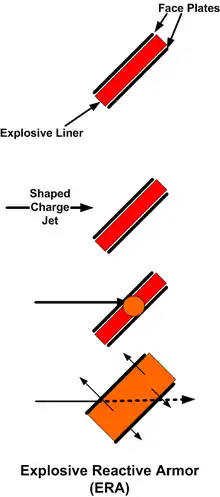Eplosive reactive armor
An element of explosive reactive armour (ERA) is made out of a sheet or slab of high explosive sandwiched between two plates, typically metal, called the reactive or dynamic elements. On attack by a penetrating weapon, the explosive detonates, forcibly driving the metal plates apart to damage the penetrator. Against a shaped charge, the projected plates disrupt the metallic jet penetrator, effectively providing a greater path-length of material to be penetrated. Against a kinetic energy penetrator, the projected plates serve to deflect and break up the rod.
The disruption is attributed to two mechanisms. First, the moving plates change the effective velocity and angle of impact of the shaped charge jet, reducing the angle of incidence and increasing the effective jet velocity versus the plate element. Second, since the plates are angled compared to the usual impact direction of shaped charge warheads, as the plates move outwards the impact point on the plate moves over time, requiring the jet to cut through fresh plates of material. This second effect significantly increases the effective plate thickness during the impact.

To be effective against kinetic energy projectiles, ERA must use much thicker and heavier plates and a correspondingly thicker explosive layer. Such heavy ERA, such as the Soviet-developed Kontakt-5, can break apart a penetrating rod that is longer than the ERA is deep, again significantly reducing penetration capability.
An important aspect of ERA is the brisance, or detonation speed of its explosive element. A more brisant explosive and greater plate velocity will result in more plate material being fed into the path of the oncoming jet, greatly increasing the plate's effective thickness. This effect is especially pronounced in the rear plate receding away from the jet, which triples in effective thickness with double the velocity.[1]

ERA also counters explosively forged projectiles, as produced by a shaped charge. The counter-explosion must disrupt the incoming projectile so that its momentum is distributed in all directions rather than toward the target, greatly reducing its effectiveness.
Explosive reactive armour has been valued by the Soviet Union and its now-independent component states since the 1980s, and almost every tank in the eastern-European military inventory today has either been manufactured to use ERA or had ERA tiles added to it, including even the T-55 and T-62 tanks built forty to fifty years ago, but still used today by reserve units. The U.S. Army uses reactive armour on its Abrams tanks as part of the TUSK (Tank Urban Survivability Kit) package and on Bradley vehicles and the Israelis use it frequently on their American built M60 tanks.
ERA tiles are used as add-on (or appliqué) armour to the portions of an armoured fighting vehicle that are most likely to be hit, typically the front (glacis) of the hull and the front and sides of the turret. Their use requires that a vehicle be fairly heavily armoured to protect itself and its crew from the exploding ERA.
A further complication to the use of ERA is the inherent danger to anyone near the tank when a plate detonates, though a high-explosive anti-tank (HEAT) warhead explosion would already cause great danger to anyone near the tank. Although ERA plates are intended only to bulge following detonation, the combined energy of the ERA explosive, coupled with the kinetic or explosive energy of the projectile, will frequently cause explosive fragmentation of the plate. The explosion of an ERA plate creates a significant amount of shrapnel, and bystanders are in grave danger of fatal injury. Thus, infantry must operate some distance from vehicles protected by ERA in combined arms operations.
References
- Held, Manfred (20 August 2004). "Dynamic Plate Thickness of ERA Sandwiches against Shaped Charge Jets". Propellants, Explosives, Pyrotechnics. 29 (4): 245–246. doi:10.1002/prep.200400051.